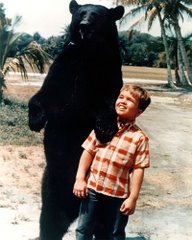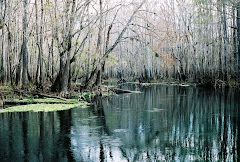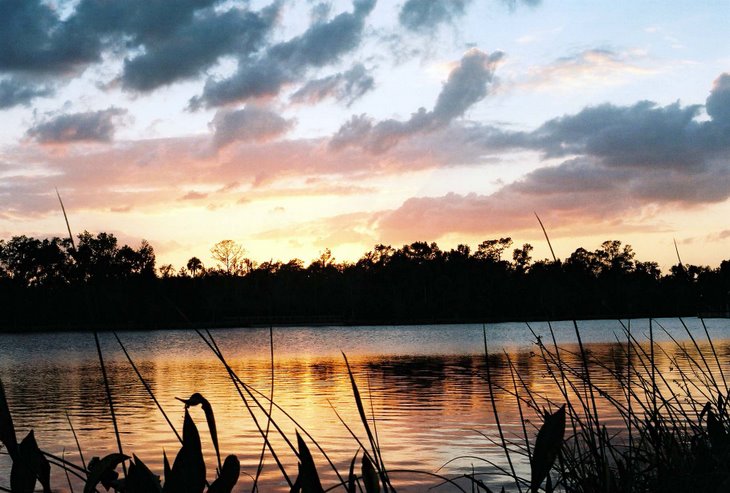Monday, October 08, 2007
Highlands Hammock State Park
This 9,000 acre park in Highlands County opened to the public in 1931 and is one of the earliest examples of grass-roots public support for environmental preservation. Local citizens, concerned about plans to turn the hammock into farmland, acquired the property and pledged to protect it. When Florida’s state park system was established in 1935, Highlands Hammock became one of the four original state parks in the newly established system.
The park preserves a scenic virgin hardwood forest, a large cypress swamp, pine flatwoods, sand pine scrub, bayheads and marsh. There are nine trails that penetrate this thickly wooded preserve, with many having boardwalks that take hikers over the marshier sections affording vistas into the mysterious and fascinating swamps below.
There is also a campground, restaurant, museum and ranger guided tram tours. Highlands Hammock is located four miles west of Sebring on County Road 634. For such a small park it is dense with natural beauty and a wide array of contrasting biomes. It is well worth the detour off of U.S. 27 if you ever happen to be in this neck of the woods.
Tuesday, October 02, 2007
Myakka River State Park
 This past Sunday we visited Myakka River State Park, one of Florida's oldest and largest (58 square miles). It is located in central Sarasota County, just seven miles east of I-75, and preserves a diverse set of distinctive natural landscapes. In addition to the Myakka River floodplain there are swamps, dense forests of hardwoods and palm, several large lakes and extensive tracts of dry prairie land. This is one of the most interesting natural areas in Florida and judging by the number of visitors very popular too.
This past Sunday we visited Myakka River State Park, one of Florida's oldest and largest (58 square miles). It is located in central Sarasota County, just seven miles east of I-75, and preserves a diverse set of distinctive natural landscapes. In addition to the Myakka River floodplain there are swamps, dense forests of hardwoods and palm, several large lakes and extensive tracts of dry prairie land. This is one of the most interesting natural areas in Florida and judging by the number of visitors very popular too.Myakka River
The park is also teeming with wildlife and on our fairly short visit we encountered: wild boar, deer, a pygmy rattlesnake, red shouldered hawks, flocks of black vultures, alligators and all kinds of interesting insects.

Wild boar

Red shouldered hawk

Upper Myakka Lake

Black vulture convention by the lake
In addition to hiking, camping and fishing there are trails for horseback riding and as well as interpretive presentations and guided hikes. You can also hop aboard one of the world's two largest airboats, the Myakka Maiden or the Gator Gal for a scenic cruise on Upper Myakka Lake or take a Tram Safari into the backcountry. There is enough room here to take extended backpacking trips into the interior but I would strongly suggest doing this in the winter when the bugs and heat are less intense. All in all a great place to enjoy the essence of natural Florida.
Saturday, September 29, 2007
Eastern Pondhawk
This morning I saw a beautiful female Eastern Pondhawk lifting off from our driveway rather unsteadily due to an overly large piece of prey that it was grasping in its mouth parts. A few seconds later this graceful insect gingerly alighted on the backyard banana tree, where it began to more earnestly chew and digest its hapless victim. Camera in hand I recorded the gripping mealtime drama for you my gentle readers in cyberspace.
It appears that it was scarfing down a male member of its own species.
Just another typical day in the bug eat bug world of the Florida jungle.
It appears that it was scarfing down a male member of its own species.
Just another typical day in the bug eat bug world of the Florida jungle.
Click on the image for a much more detailed view.
Wednesday, September 19, 2007
Birds of my neighborhood
The weather has been breezy and a bit cooler the past few days so I've been taking longer walks after dinner with my camera to see what kinds of animals I could capture in the viewfinder for you my dear readers out there in cyberspace.
Here in the swamps and lakes of central Florida the bird life is what has struck this newcomer the most. It looks and feels like I live in an exotic jungle paradise. Well maybe I do.

Wood stork

Florida wild turkey or also known as the Osceola
 Woods that surround the ponds
Woods that surround the ponds
 This gator was watching me take pictures.
This gator was watching me take pictures.
Here in the swamps and lakes of central Florida the bird life is what has struck this newcomer the most. It looks and feels like I live in an exotic jungle paradise. Well maybe I do.

Wood stork

Florida wild turkey or also known as the Osceola
 Woods that surround the ponds
Woods that surround the ponds This gator was watching me take pictures.
This gator was watching me take pictures.Tuesday, September 18, 2007
Golden orb weaver
This morning my wife beckoned me to come out on the back porch to welcome a newly arrived guest at our Florida jungle outpost. During the overnight hours a beautiful Golden orb weaver (Argiope aurantia) had spun a most delicately graceful web above the barbecue prep table.


According to my trusty copy of The Golden Guide to Spiders: "Argiopes are large, conspicuous spiders that hang head down in the center of the web. The web usually has crossed zigzag bands, and the young spiders may construct more zigzags than the adults. Some species are easily recognized by their color and pattern. Species of Argiope are found in tropical and temperate regions."
Now to find something to feed this hungry girl.......
Now to find something to feed this hungry girl.......
Friday, August 31, 2007
Golden silk spider
When traveling between the Panhandle and central Florida we always try to take a break at the mid-way point in the small logging town of Perry. If it is still light we prefer to stop at a state historical park on the south end of town which commemorates Florida's long leaf pine forests and their contribution to the state's history and development.
On our latest journey we arrived at dusk to stretch our legs and use the restroom. I took a short stroll along the edge of a thickly wooded area that gently slopes down into a large bug infested swamp. It was here that I encountered some very large and colorful specimens of Nephila clavipes, commonly known as the golden silk spider.
According to the University of Florida science website: "The golden silk spider is found throughout Florida and the southeastern United States. The female is distinctively colored, and is among the largest orb-weaving spiders in the country. The female is 25 mm to 40 mm long and has conspicuous hair tufts on her long legs. Males are about 4 mm to 6 mm long, dark-brown, and are often found in the webs of females. These spiders feed primarily on flying insects, which they catch in webs that may be greater than a meter in diameter. They are most commonly found in forests, along trails and at clearing edges."
On our latest journey we arrived at dusk to stretch our legs and use the restroom. I took a short stroll along the edge of a thickly wooded area that gently slopes down into a large bug infested swamp. It was here that I encountered some very large and colorful specimens of Nephila clavipes, commonly known as the golden silk spider.
According to the University of Florida science website: "The golden silk spider is found throughout Florida and the southeastern United States. The female is distinctively colored, and is among the largest orb-weaving spiders in the country. The female is 25 mm to 40 mm long and has conspicuous hair tufts on her long legs. Males are about 4 mm to 6 mm long, dark-brown, and are often found in the webs of females. These spiders feed primarily on flying insects, which they catch in webs that may be greater than a meter in diameter. They are most commonly found in forests, along trails and at clearing edges."
Tuesday, July 10, 2007
Florida Has Giant Spiders
This morning, as I was minding my own business in the garage, I came upon what has to be the largest Wolf Spider I've ever seen. Its body was at least two inches long and from the look of things it had been eating quite well in the murky darkness, as there were lots of hollowed out insect carcasses laying around the immediate vicinity of this enormous arachnid. My guess is that this is a Rabid Wolf Spider (Lycosa rabida) but will patiently await the scrutiny of my panel of experts out there in cyberspace.
According to the Audubon Field Guide To Insects & Spiders: "This species is harmless to people, but its bite is often feared----hence its common name. According to a legend, the only way to save a victim bitten by the related European Tarantula is to dance the tarantella."
In other words you'd better watch where you're walking when it's summertime in Florida.
According to the Audubon Field Guide To Insects & Spiders: "This species is harmless to people, but its bite is often feared----hence its common name. According to a legend, the only way to save a victim bitten by the related European Tarantula is to dance the tarantella."
In other words you'd better watch where you're walking when it's summertime in Florida.
Saturday, May 12, 2007
Cruise to Shell Island
 One of the better island adventure bargains in the world can be found in Panama City, FL where cruises are conducted daily to beautiful Shell Island. This barrier island is located on the opposite side of St. Andrews Bay and fronts on the Gulf of Mexico.
One of the better island adventure bargains in the world can be found in Panama City, FL where cruises are conducted daily to beautiful Shell Island. This barrier island is located on the opposite side of St. Andrews Bay and fronts on the Gulf of Mexico.Shell Island is about 12 miles long and completely undeveloped. Most of the land is administered as a part of nearby St. Andrews State Park and the only way to get there is by boat. When you arrive you will encounter a pristine wilderness paradise located a mere stones throw from a bustling commerical harbor and nearby miltary bases. For $16 you get a three and half hour tour (lunch included) with a one hour stay on the island to collect shells and frolic in the crystal clear waters of its Gulf beach front. This being Florida the boat has a snack concession and a full service bar. What more could y'all want? After Memorial Day there are three trips a day so you can arrange to stay longer on the island if you so desire. So what are you waiting for? Get thee to Shell Island!

Atlantic bottlenose dolphin
 Coming ashore on Shell Island
Coming ashore on Shell Island
Pristine beach

Crystal clear water of St. Andrews Bay

Leaving Shell Island
For more information: http://www.shellislandcruises.com/
Monday, April 02, 2007
Manatee Springs State Park
Manatee Springs State Park is in Levy County along the east bank of the Suwannee River near the town of Chiefland. Over 100 million gallons of water flow from this first magnitude spring every day into the Suwannee. The water rises to the surface through a large underground aquatic cave system that is believed to be one of the longest in North America.
The warm waters of the spring attract West Indian manatees in the winter. They swim up the Suwannee River from the Gulf of Mexico to spend the colder months near this source of warmth and refuge. These magnficent mammals are a favorite attraction for park visitors.
The park is divided into two distinct sections with the area around the springs and the quarter-mile run it forms to the Suwannee dominated by water-loving trees like cypress, tupelo, gum, ash and maple. The uplands of the park are drier and contain a sandhill plant community that contains turkey oak, longleaf pine, wiregrass and palmetto.
18th century naturalist William Bartram was the first person to describe Manatee Springs in detail and also to note the presence of manatees. The area was once famous for its old growth cypress trees, with some specimens being over 3,000 years old. Cedar was also extensively logged here by the pencil industry in the late 19th century and was processed and shipped from nearby Cedar Key in the Gulf of Mexico.
Activities include swimming, scuba diving, fishing, boating and hiking. There is a campground and food concession near the spring. The best time to view manatees is November through April.
For more information: http://www.floridastateparks.org/manateesprings/
The warm waters of the spring attract West Indian manatees in the winter. They swim up the Suwannee River from the Gulf of Mexico to spend the colder months near this source of warmth and refuge. These magnficent mammals are a favorite attraction for park visitors.
The park is divided into two distinct sections with the area around the springs and the quarter-mile run it forms to the Suwannee dominated by water-loving trees like cypress, tupelo, gum, ash and maple. The uplands of the park are drier and contain a sandhill plant community that contains turkey oak, longleaf pine, wiregrass and palmetto.
18th century naturalist William Bartram was the first person to describe Manatee Springs in detail and also to note the presence of manatees. The area was once famous for its old growth cypress trees, with some specimens being over 3,000 years old. Cedar was also extensively logged here by the pencil industry in the late 19th century and was processed and shipped from nearby Cedar Key in the Gulf of Mexico.
For more information: http://www.floridastateparks.org/manateesprings/
Sunday, April 01, 2007
Spring Flowers
The naming of Florida is credited to Ponce de Leon who christened this land in 1513 with a Spanish term Pascua Florida, meaning “feast of flowers” which was also another word for Easter. With this in mind I thought it fitting to showcase a photo gallery of flowers that we observed today on this most splendid Palm Sunday.
The photographs were taken in two state parks about ten miles apart (Camp Helen and Eden Gardens) where the signs of spring were everywhere in evidence. Have a Happy Easter week everyone!
Subscribe to:
Posts (Atom)










































